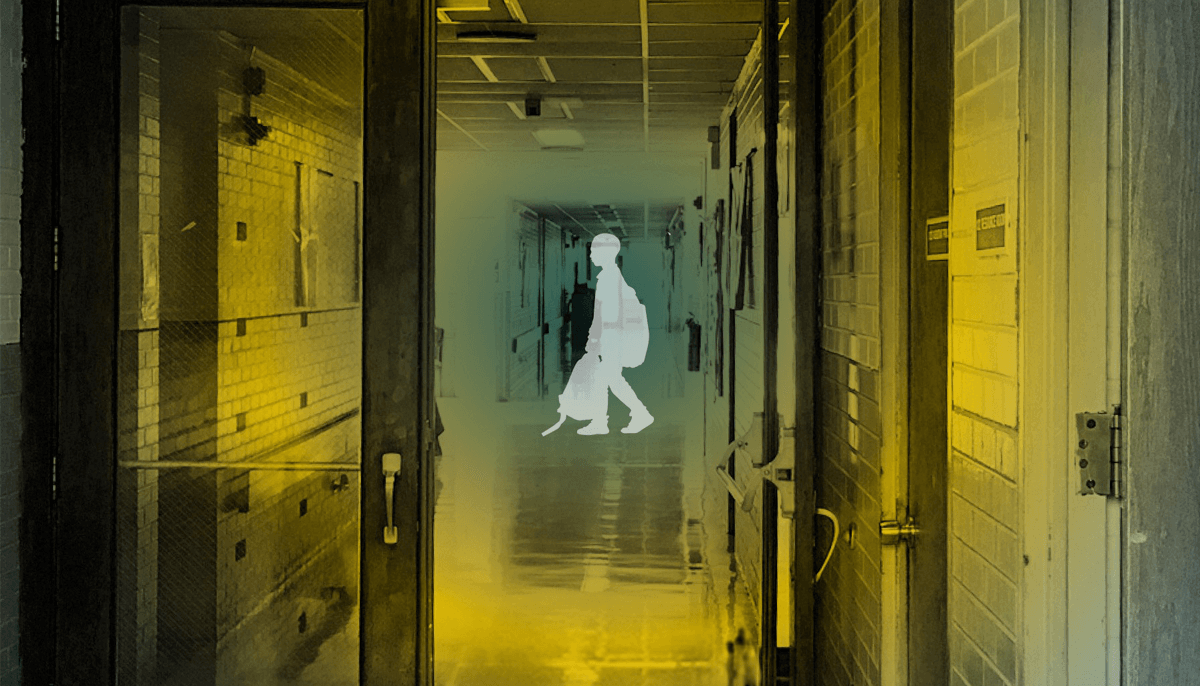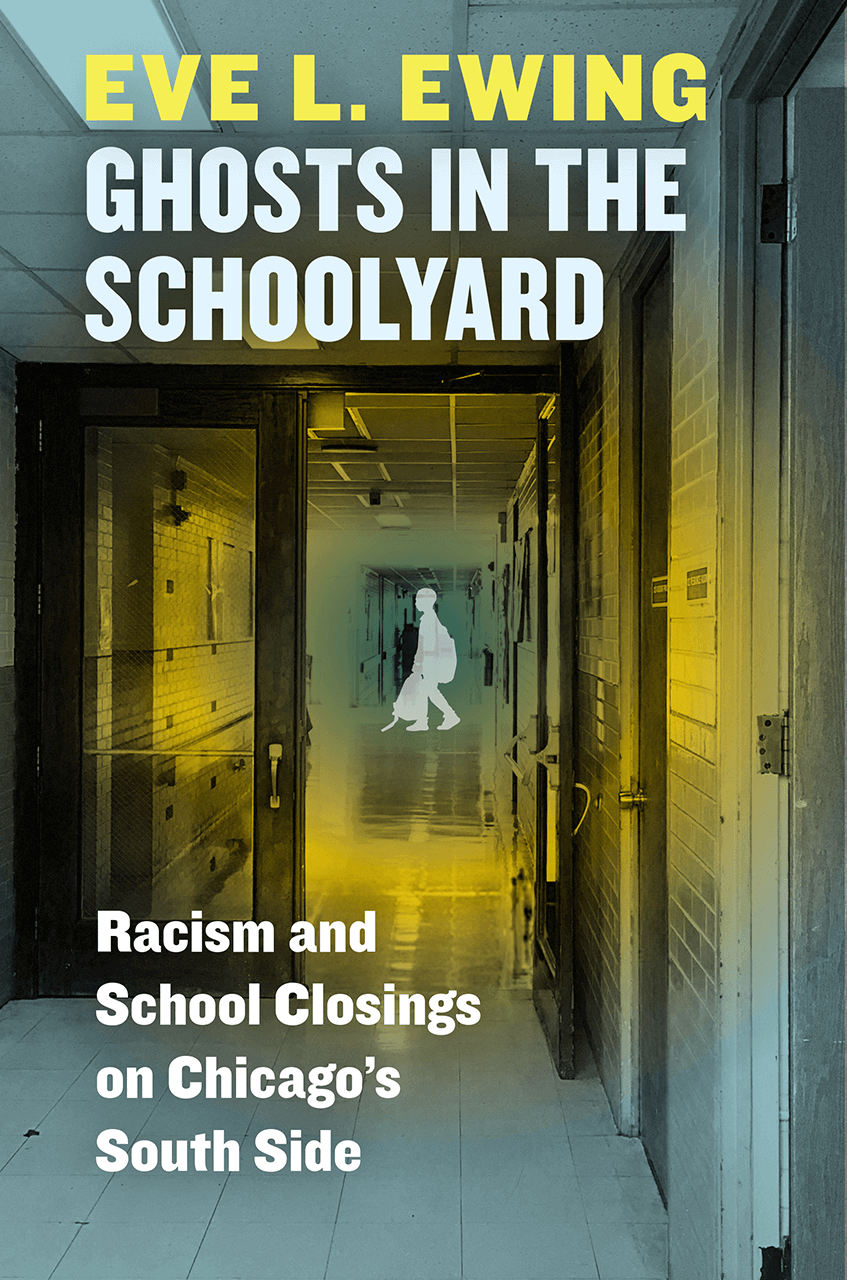
Ghosts in the Schoolyard: Racism and School Closings on Chicago’s South Side
by Eve L. Ewing
University of Chicago Press, 2018, $22.50; 240 pages.
As reviewed by Marilyn Anderson Rhames
 Have you ever wondered why some black parents have staged vigorous protests—and even gone on hunger strikes—to save their children’s “failing” public schools from being closed? Want to peek behind what W. E. B. Du Bois dubbed “the Veil” to unpack the often misunderstood intricacies of the segregated black life? Ready to hear a 100-year backstory of hatred, housing redlining, and educational isolation that led up to the Chicago Public Schools closing of 49 mostly black schools in the summer of 2013?
Have you ever wondered why some black parents have staged vigorous protests—and even gone on hunger strikes—to save their children’s “failing” public schools from being closed? Want to peek behind what W. E. B. Du Bois dubbed “the Veil” to unpack the often misunderstood intricacies of the segregated black life? Ready to hear a 100-year backstory of hatred, housing redlining, and educational isolation that led up to the Chicago Public Schools closing of 49 mostly black schools in the summer of 2013?
It’s all there in Eve Ewing’s book, Ghosts in the Schoolyard. Ewing, an assistant professor at the University of Chicago School of Social Service Administration, makes it clear from the jump that she is not impartial on the topic. As a black woman who grew up in Chicago and taught in the city’s schools, Ewing views the closures—the largest mass school closings in American history—as yet another racist assault on the black community, which has never been allowed to fully integrate into the fabric of white Chicago. Even with her unapologetic bias, Ewing draws on an abundance of one-on-one interviews, observations, transcripts from school closing hearings, and statistics on race, housing, and education to produce a compelling academic case study.
As much as I enjoyed learning from the book, I do wish that Ewing had offered readers a more thorough, point-by-point takedown of Chicago Public Schools’ reasons for the school closings. That would have provided a more balanced argument for those who were genuinely undecided about what to make of the situation. It also might have quelled the criticism that Ewing’s book is little more than 200-plus pages of identity politics and that it doesn’t address the thorny issue of what to do with schools that are under-enrolled and have poor student achievement.
The book focuses on the four schools in the city’s Bronzeville community that were slated to close and how one of them, Walter H. Dyett High School, narrowly managed to escape.
 Ewing challenges the narrative that Barbara Byrd-Bennett, then CEO of the Chicago Public Schools (who, incidentally, is now in federal prison for bribery), gave to justify closing the schools. Byrd-Bennett had insisted that the schools were “underutilized” and “under-resourced.” “How,” Ewing asks, “could the person charged with doling out resources condemn an institution for not having enough resources?”
Ewing challenges the narrative that Barbara Byrd-Bennett, then CEO of the Chicago Public Schools (who, incidentally, is now in federal prison for bribery), gave to justify closing the schools. Byrd-Bennett had insisted that the schools were “underutilized” and “under-resourced.” “How,” Ewing asks, “could the person charged with doling out resources condemn an institution for not having enough resources?”
While Byrd-Bennett and Mayor Rahm Emanuel (who appoints the schools chief and board members) tried to justify the closing of nearly 50 schools because they were “chronically failing,” Ewing argues that residents saw these actions as an affront to their democratic right to decide on the best way to provide a high-quality education for their children. She writes:
We see that this community’s choice to resist a school’s being characterized as “failing” is in fact about much more than the school itself: it is about citizenship and participation, about justice and injustice, and about resisting people in power who want to transform a community at the expense of the people who live there.
Bronzeville, the three-square-mile neighborhood on Chicago’s South Side where some 30,000 black migrants fleeing the Jim Crow South had settled by 1900, grew to 109,000 people by 1920, expanding at a rate that was more than double what the rest of the city underwent. This corridor between 22nd and 51st Streets was once called the “Black Belt” or “Black Ghetto” or worse, “Blackie Town,” but it was ultimately dubbed “Bronzeville” by James Gentry, theater critic and editor for the black newspaper the Chicago Bee. This black metropolis was once home to cultural icons like Ida B. Wells, Richard Wright, Gwendolyn Brooks, Sam Cooke, Nat King Cole, and Mahalia Jackson, among many others.
Bronzeville’s population was bursting at the seams by the late 1940s, and while it was graced with a high concentration of black talent and ingenuity, the community had to struggle with social isolation, violence, and abject poverty. Ewing details how Bronzeville was surrounded by white communities where property owners had signed restrictive covenants agreeing not to sell homes or office space to black people—and how the enforcers of those covenants firebombed nearly 60 homes and businesses of black people who managed to move into those communities anyway. With multiple families living in single “kitchenettes”—tiny, poorly equipped apartments carved from larger rental units—the housing crisis in Bronzeville became untenable. The city’s leaders, most notably Mayor Richard J. Daley and his schools chief Benjamin Willis, refused to promote integration, which led to the construction of low- and high-rise public-housing projects for Bronzeville residents from the 1950s through the 1970s. That activity was paired with the rapid building of new schools so that black families would stop demanding that their children be allowed to fill the thousands of vacant seats in nearby white schools.
Ewing takes the reader through one racist public policy after another, culminating, she asserts, in 2013, when the school system shuttered 49 schools, 90 percent of which served all-black student populations. These closings followed a drastic drop in student enrollment in neighborhood schools in Bronzeville and other black communities on Chicago’s South and West Sides. The enrollment decline was itself an upshot of a misguided urban “renewal” policy: after the Ida B. Wells, Robert Taylor, Harold L. Ickes, and Stateway Gardens housing projects—which were constructed to contain black people within the boundaries of Bronzeville—were demolished in the late 1990s and early 2000s, thousands of black residents were pushed out of the neighborhood to find housing. (In the past decade, the black population has declined throughout Chicago, a phenomenon dubbed “black flight,” spurred by street violence and a lack of economic opportunity.)
Ewing gives voice to community members who are still grieving the death of their schools as one might lament the loss of a loved one. Indeed, she devotes an entire section of the book to this sense of mourning. She writes:
In the public narrative about closed schools, there are stories we rarely hear. Using words like love in a conversation about education policy feels almost taboo, or somehow in poor taste. . . . Instead, closing schools are presented as uniformly valueless, without worth, and characterized by criteria that are as far as you can get from something as base and as messy as human emotion. How many students can the building hold? How much will it cost to repair it? What test scores did it have last year? But to those closest to these schools, these questions swim beneath the surface of something much more important: love.
Readers of this book will come to understand why a group of community activists and parents staged a 34-day hunger strike (involving two hospitalizations) to keep open Walter H. Dyett High School, a so-called “failing” school. They will discover why Ewing describes this school named after a local music teacher as “a testimony to the history of black education in Bronzeville, to a hero and the geniuses under his care, to an institution that successfully educated black children to be great in an era when expectation for their lives were meager. With this understanding, an attack on the legendary Dyett name was an attack on history and identity.”
After reading this book, readers might think twice before labeling yet another segregated, under-resourced, all-black school as “failing.”
If all the pain and trauma of the mass school closings produced positive results for the students involved, they might be forgiven by history. Unfortunately, a comprehensive five-year study from the University of Chicago Consortium on School Research showed that the 12,000 students displaced by the closure saw their standardized test scores decline, even as their attendance and GPAs held steady.
As I was reading Ewing’s book on a plane, my seatmate, a white woman in her 40s, asked me about it. She has lived in downtown Chicago for more than a decade and had not heard that nearly 50 schools in Chicago’s black neighborhoods had closed. It was a sad reminder to me that, even today, some white residents remain wholly unaware that their city leaders shut down some 50 schools in black neighborhoods, angering and traumatizing communities. Ewing’s book, though, makes it clear that it’s the city leadership that has “failed” the schools, not the other way around.
Marilyn Anderson Rhames is an education writer and the founder and CEO of the nonprofit Teachers Who Pray. Born and raised on Chicago’s South Side by parents and grandparents who joined the Great Migration from Mississippi in the 1950s and ’60s, Rhames taught in the city’s public schools for nearly 15 years.
Another review of this book, by Paul E. Peterson, can be found here.
This article appeared in the Summer 2019 issue of Education Next. Suggested citation format:
Peterson, P.E., and Rhames, M.A. (2019). Shuttering Schools in Chicago: Scholar links closings to city’s history of discrimination. Education Next, 19(3), 75-78.


